|
Day 9
Fairbanks To Denali National Park
Highlights
This was our first full day in Alaska. We took a much touted tour of Riverboat Discovery to learn about life in Alaska with focus on native people. After a short return to the Museum Of The North, we headed to Denali National Park, barely in time to scramble to find a place to stay since all campgrounds in the park was full. Once that's setlled, we headed into the park and drove the portion of the road where there was no restriction.
Day Journal
Riverboat Discovery Tour |
|
We woke up to heavy rain which unfortunately was only a prelude to the days to come.Our main activity for the day was to take the Riverboat Discovery Tour, which was highly touted by both locals and travel sites. We had bought the tickets online the previous night since we wanted to ensure an early time. If time is not a major factor, one could just as well buy tickets at the Discovery Trading Post. Finding the dock for the boat was a little challenge for us without a good map since the place was a bit out of the way. With help from a friendly local, we managed to get to the place well in time for the tour. When we arrived, the place was bustling with people and traffic. There were rows of tour buses, RV's and passenger cars. Then it took some asking around to find the ticket office to inquire about our online purchase, but within a short time, things settled down for us and we got to relax and observed the many things that was going on. There were many families with little children, yet there were also many older people, including those in wheelchairs, alll moving around for one reason or another. To top it off, there were several contestants for the Miss World Eskimo Indian Olympics joining the tour, with people interviewing and taking pictures abound. It was lively!
Eventually, we board the Discovery riverboat for the tour. The boat by itself is worth talking about - it's a beautiful sternwheeler with 4 decks. The boat was well maintained with a fresh coat of paint when we were there. Overall, the tour was very well organized, and packed with diversed, interesting and informative segments. Aside from the time fillers facts narrated by the tour master, these segments were most interesting to us: |
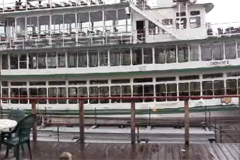 |
| Bush plane show: A bush plane taking off and landing on the river. This type of planes is quite versatile for conditions in Alaska. They can take off and land from tundra fields, water, roads or frozen rivers just by changing out the landing gears. Bush planes sent most riverboats into retirement. While it might look easy during the summer time, taking off and landing during inclement weathers and winter time would be quite a challenge. Due to the lack of highways and abundance of waterways, Alaska has the highest per capita licensed pilots than any other state. |
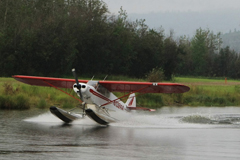 |
Dog sledding show: A demonstration of dog sledding by Dave Monson, the husband of the late Susan Butcher. The story of Susan Butcher is inspirational for her determination, courage and successes. Competing in the grueling 1110-mile Iditarod Race in artic blizzards, she won four out of five races in sequential years. She received numerous awards including "Female Athelete of the Year". She died in 2006 from leukemia. Among her famous quote, here is one about quitting: "I do not know the word 'quit.' Either I never did, or I have abolished it." The demonstration of dogsledding was quite interesting for people like me who have never seen one before. The sight and sound of excited dogs before, during and after the demo was quite lively and can only be appreciated by being there. These dogs were treated like part of the family, and showed their enthusiasm in being harnessed for the run. After the run, many jumped in the river to cool off and drink. |
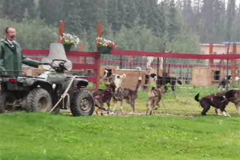 |
- Puppy water training - Puppies are trained to get used to water since they will eventually encounter freezing water on the trail. In this case, the puppies were reluctant to get in the water, requiring some brute force approach for the show :)
- The dog sled run: Dave Monson demonstrated a run with a ATV. The dogs were quite enthusiastic doing it. Even dogs remaining in the kennel joined in the chorus, making the whole show quite lively.
- Swimming in the river: Upon returning home, several dogs jumped in the river to cool off and grab a drink!
|
|
Chena River meets Tanana River: The place where the clear spring-fed Chena River meets with the silty water of the Tanana River presenting a unique pattern of water stream collision that resembles clouds in the sky. While Chena River looks like many rivers in the lower states, Tanana River carries silts from glaciers and therefore the water is muddy, and also due to the vast amount of debris being carried by the river, water channels open up or close down randomly, making the river a lot bigger and with many channels. Tanana has another distinction having nothing to do with rivers - A tripod is planted in the middle of the river when the water freezes, and betting takes place to guess when the tripod moves due to melting. The prize was over $270,000 in 2010. |
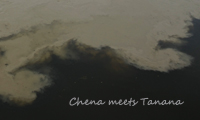 |
Chena Indian Village: An hour-long information packed and well presented visit to the Chena Indian Village. This is our favorite part of the tour, with well orchestrated sessions about Athabascan life and culture - from dress making to hunting and transportation.The tour guide was quite charming and equipped with funny lines throughout their presentations.We thoroughly enjoyed it. There were other exhibits that we did not get time to see such as the dog kennel, etc. We did manage to stop by the old post office and bought several Susan Butcher books to give to kids.
Below includes further information about the various presentations and short videos that were both informative, interesting and funny. |
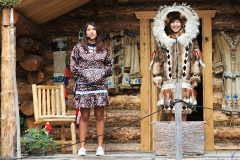 |
- Athabascan Fish Camp - Salmon is abundant in this region, and Athabascan Indians life evolves around it for much of the summer months. In this village, there was a model fish camp representative of those still in operation in Athabascan villages. There are many structures in a fish camp, designed to catch and process a large quantity of salmon such as fish wheel, smoke house, housing for human and dogs, and storage. There was a working fishwheel that the Athabascan perfected to catch upward of a thousand of salmon a day, so much so that they are only allowed to operate for a certain time of the year. A fish wheel consists of two large baskets and paddles designed to rotate when the water flow, and while rotating catch fish. It's much easier to show how it works than trying to describe. So here is a short video of a fish wheel in motion. There is a 6-part video of Nicole's presentation about life around the fish camp, from housing structures to smoking and cooking salmon.
|
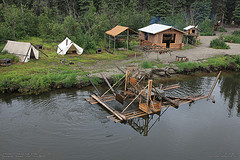 |
|
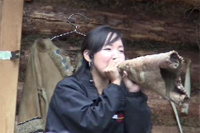 |
|
Out of curiosity, I dug a bit deeper into native Alaskan culture and found out that the Athabascan is a large Indian ethnic group, comprising of many branches including the one we visited which seem to be those from the interior of Alaska around the Tanana River Valley. There are several more branches and to my surprise, including the Apaches and Navajos in the lower US. From the anthropology perspective, there are three different groups in Alaska - the Eskimos, Indians, and Aleuts, of which the Indians comprise the largest number of people. Researching further into various ethnic groups revealed fascinating facts about the Athabascan life, the subject of a different post as some point. |
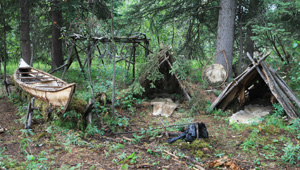 |
Road to Denali
In our typically travel style of "playing by ear", we discussed whether to spend another day in Fairbanks or moving on afther lunch. Our impression of Alaska improved greatly after the visit to the museum and the Riverboat tour, and we felt we could enjoy Fairbanks at least another day. We also enjoyed our encounters with local Fairbanks people. However, we began to feel the pressure of time . We used up a third of our allotted time for the trip but only have toured Alaska for one day, and so much more we'd like to see. So, we decided to drive on to Denali National Park. Not knowing much about the park, and enough to know that it can be crowded during the summer months, we accepted the risk of not finding a place to stay in the park and would have to find alternative lodging options. Leaving Fairbanks pretty late in the day, lodging outside the park was almost a certainty.
The drive to Denali was much more interesting than the previous day. Alaska Highway 3 was very scenic, especially in Denali Borough near the park. Our only real surprise was to find several forest fires along the highway despite the constant rain that we had encountered. We met a local who told us that these fires can last for months even with the rain because they burned under deep layers of dead leaves or moss, undisturbed by rain - rain would stop rain on the ground level, but when it stops, fire smoldering underground would reignite the forest fires. Correlating what he said with what we were told about punk (fungus on birch) can keep fires smoldering for days, we now could appreciate why such fire would be hard to put out. Only the arrival of the cold winter months would finally put these fires out.
As usual, we ran into road constructions along the way. The only twist was the long line of RVs and trucks queueing up at each stop made our average travel speed quite slow even though we drove fast on low-traffic stretches of roads. The rain also returned as we approached the park, although fortunately, it was light. |
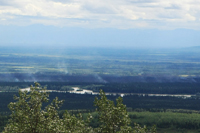 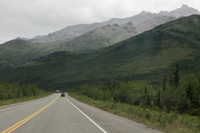 |
Denali National Park and Preserve |
|
We arrived at Denali late in the afternoon within 30 minutes of visitor closing time, so it was quite a scramble to find out where to go to find camping and to take park tours. The park lived up to its reputation of being crowded during the summer months. We did not find a place to stay for that night in the park, but managed to get a campsite for the following day, and booked a bus tour for the same. A word from experience: Read about the park before going since it's a rather confusing set up. We went to the Visitor Center to find information and book campground/tour, but these are done at the Wilderness Acess Center instead, making it even more of a rush for us. And when we arrived at the Wilderness Access Center, there were so many choices of campgrounds, each with its own advantages and restrictions. Likewise, bus tours also have different types and different destinations. So, read up about all these options before you arrive, and better yet, make advanced reservation! This was one in a few times when our impromptu style did not work that well for the trip.
After booking the following day activities and campsite, we got back to the highway and retraced our drive to a RV campground we had seen earlier. Securing a campsite there was not an issue, that is until the night when we could not sleep well due to the constant truck traffic through the night within thirty feet from our ears. We should have heeded the advice of the park attendant to go to another affiliated campground better suited for tent camping. But that was the way it went - you win some and you lose some.
Having a place to stay for the night, we felt much better and decided to return to the park to drive the Denali Park Road section that is open to the public - some 15-mile stretch of paved road. Beyond that point, permits are required. The park road was rather tame for a while, but eventually opened up with beautiful mountain vista. We also made a short stop to walk the Savage Cabin Interpretive Loop Trail. This drive helped us unwind from the stress of various bookings earlier. |
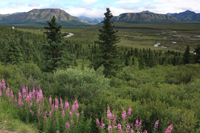 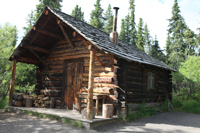 |
Roads and Weather
The roads were generally well maintained, except for sections undergoing maintenance. Due to the high volume of traffic, each road work with one-way traffic control was nightmarish in term of keeping to a schedule. The long caravan of trucks and RVs made it hard to pass slower vehicles for a long time. Even if one drives at 70 MPH, expect the average highway speed to be under 50. It should be mentioned that people maintaining Alaska highways were all hard workers and the result of their work was superb. I could not say the same for some delays during our travel in the lower 48 states where some works appeared dubious and inefficient on the surface.
The weather was gloomy and rainy for most of the day, with only a brief period of sunshine toward the end of the evening.
Links
|